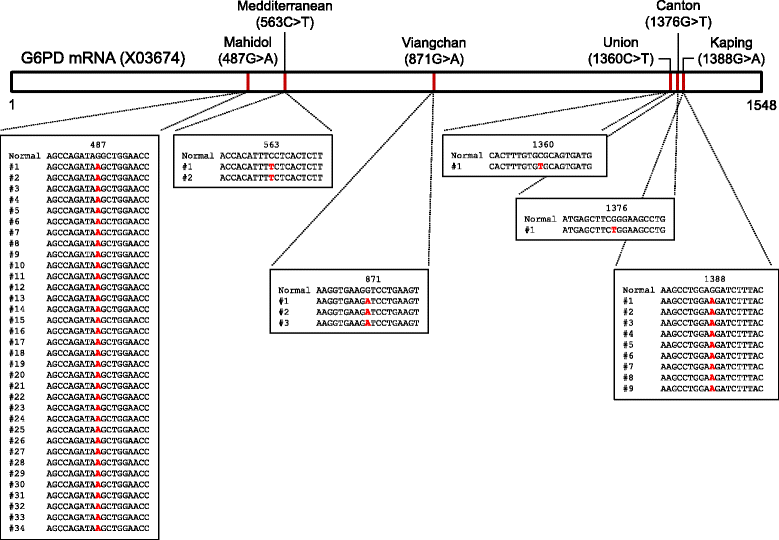Prevalence of glucose-6-phosphate dehydrogenase (G6PD) deficiency among malaria patients in Upper Myanmar
- PMID: 29548282
- PMCID: PMC5857094
- DOI: 10.1186/s12879-018-3031-y
Prevalence of glucose-6-phosphate dehydrogenase (G6PD) deficiency among malaria patients in Upper Myanmar
Abstract
Background: Glucose-6-phosphate dehydrogenase (G6PD; EC 1.1.1.49) deficiency is one of the most common X-linked recessive hereditary disorders in the world. Primaquine (PQ) has been used for radical cure of P. vivax to prevent relapse. Recently, it is also used to reduce P. falciparum gametocyte carriage to block transmission. However, PQ metabolites oxidize hemoglobin and generate excessive reactive oxygen species which can trigger acute hemolytic anemia in malaria patients with inherited G6PD deficiency.
Methods: A total of 252 blood samples collected from malaria patients in Myanmar were used in this study. G6PD variant was analysed by a multiplex allele specific PCR kit, DiaPlexC™ G6PD Genotyping Kit [Asian type]. The accuracy of the multiplex allele specific PCR was confirmed by sequencing analysis.
Results: Prevalence and distribution of G6PD variants in 252 malaria patients in Myanmar were analysed. Six different types of G6PD allelic variants were identified in 50 (7 females and 43 males) malaria patients. The predominant variant was Mahidol (68%, 34/50), of which 91.2% (31/34) and 8.8% (3/34) were males and females, respectively. Other G6PD variants including Kaiping (18%, 9/50), Viangchan (6%, 3/50), Mediterranean (4%, 2/50), Union (2%, 1/50) and Canton (2%, 1/50) were also observed.
Conclusions: Results of this study suggest that more concern for proper and safe use of PQ as a radical cure of malaria in Myanmar is needed by combining G6PD deficiency test before PQ prescription. Establishment of a follow-up system to monitor potential PQ toxicity in malaria patients who are given PQ is also required.
Keywords: G6PD deficiency; Glucose-6-phosphate dehydrogenase (G6PD); Malaria; Myanmar; Primaquine.
Conflict of interest statement
Ethics approval and consent to participate
This study was approved by the Ethics Review Committee, Department of Medical Research, Myanmar (1/Ethics/DMRUM/2013 and 97/Ethics 2015), and by the Ethical Review Committee of Inha University School of Medicine, Korea (INHA 15–013). Informed written consent was obtained from each patient.
Consent for publication
Not applicable.
Competing interests
The authors declare that they have no competing interests.
Publisher’s Note
Springer Nature remains neutral with regard to jurisdictional claims in published maps and institutional affiliations.
Figures


Similar articles
-
Prevalence of glucose-6-phosphate dehydrogenase (G6PD) deficiency in Gia Lai Province, Vietnam.Parasitol Int. 2024 Jun;100:102868. doi: 10.1016/j.parint.2024.102868. Epub 2024 Feb 21. Parasitol Int. 2024. PMID: 38387679
-
Glucose-6-phosphate dehydrogenase deficiency prevalence and genetic variants in malaria endemic areas of Colombia.Malar J. 2016 May 26;15(1):291. doi: 10.1186/s12936-016-1343-1. Malar J. 2016. PMID: 27225440 Free PMC article.
-
Prevalence and Molecular Characterization of Glucose-6-Phosphate Dehydrogenase Deficiency at the China-Myanmar Border.PLoS One. 2015 Jul 30;10(7):e0134593. doi: 10.1371/journal.pone.0134593. eCollection 2015. PLoS One. 2015. PMID: 26226515 Free PMC article.
-
Use of primaquine and glucose-6-phosphate dehydrogenase deficiency testing: Divergent policies and practices in malaria endemic countries.PLoS Negl Trop Dis. 2018 Apr 19;12(4):e0006230. doi: 10.1371/journal.pntd.0006230. eCollection 2018 Apr. PLoS Negl Trop Dis. 2018. PMID: 29672516 Free PMC article. Review.
-
G6PD deficiency: global distribution, genetic variants and primaquine therapy.Adv Parasitol. 2013;81:133-201. doi: 10.1016/B978-0-12-407826-0.00004-7. Adv Parasitol. 2013. PMID: 23384623 Review.
Cited by
-
Prevalence of Glucose-6-Phosphate Dehydrogenase (G6PD) Deficiency among Malaria Patients in Southern Thailand: 8 Years Retrospective Study.Korean J Parasitol. 2022 Feb;60(1):15-23. doi: 10.3347/kjp.2022.60.1.15. Epub 2022 Feb 23. Korean J Parasitol. 2022. PMID: 35247950 Free PMC article.
-
Factors hindering coverage of targeted mass treatment with primaquine in a malarious township of northern Myanmar in 2019-2020.Sci Rep. 2023 Apr 12;13(1):5963. doi: 10.1038/s41598-023-32371-4. Sci Rep. 2023. PMID: 37045879 Free PMC article.
-
Geographical Accessibility to Glucose-6-Phosphate Dioxygenase Deficiency Point-of-Care Testing for Antenatal Care in Ghana.Diagnostics (Basel). 2020 Apr 16;10(4):229. doi: 10.3390/diagnostics10040229. Diagnostics (Basel). 2020. PMID: 32316233 Free PMC article.
-
Preliminary Study of Structural Changes of Glucose-6-Phosphate Dehydrogenase Deficiency Variants.Biomedicine (Taipei). 2022 Sep 1;12(3):12-19. doi: 10.37796/2211-8039.1355. eCollection 2022. Biomedicine (Taipei). 2022. PMID: 36381187 Free PMC article.
-
Single-Drop Blood Detection of Common G6PD Mutations in Thailand Based on Allele-Specific Recombinase Polymerase Amplification with CRISPR-Cas12a.ACS Omega. 2023 Nov 15;8(47):44733-44744. doi: 10.1021/acsomega.3c05596. eCollection 2023 Nov 28. ACS Omega. 2023. PMID: 38046356 Free PMC article.
References
Publication types
MeSH terms
Substances
Grants and funding
LinkOut - more resources
Full Text Sources
Other Literature Sources
Medical
Miscellaneous

